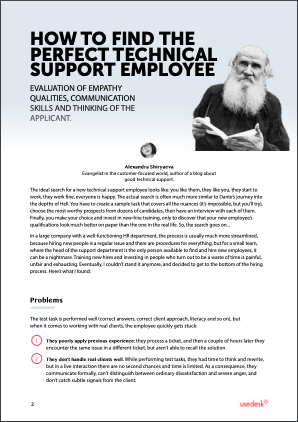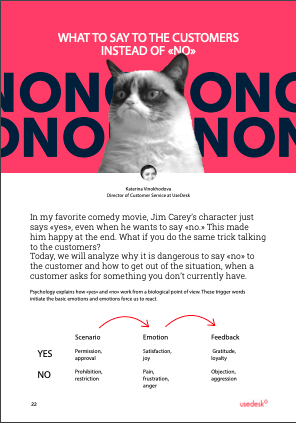Request a Demo
Send us a request for an online demonstration at the time that's convenient for you. We will give you an overview and answer any questions you may have about the system.
By clicking the button, you agree that you have read our Privacy Policy
International Payment System Company
"How we sorted everything out in the Support department and stopped worrying about lost requests"
www.payu.ru
www.payu.ru
Given: a team of 4 people, Outlook, everlasting flow of e-mails from payers and merchants.
Tool: Service for working with customers' requests UseDesk.
Establish from the beginning e-mail support, obtain satisfied customers without any loses.
Tool: Service for working with customers' requests UseDesk.
Establish from the beginning e-mail support, obtain satisfied customers without any loses.
1. E-mail Sorting
We had: Two e-mails: support@ and info@. Here we received e-mails from merchants, customers, spam and internal conversations.
Problem: E-mails on different subjects are mixed up, addressees received e-mails with delays, the important information is being deleted and forgotten. Which e-mail is important and which one can wait? Which one is repeated? Why hasn't this request been closed? Has this e-mail been responded yet?
Problem: E-mails on different subjects are mixed up, addressees received e-mails with delays, the important information is being deleted and forgotten. Which e-mail is important and which one can wait? Which one is repeated? Why hasn't this request been closed? Has this e-mail been responded yet?

What we did: We created an e-mail address for internal uses in Outlook, and support and info e-mails connected to UseDesk.
Now:
The team receives messages on Usedesk and don't waste time on sorting the irrelevant ones. They work with them right away. It became easier to control the flow since the request status is always seen:
Now:
The team receives messages on Usedesk and don't waste time on sorting the irrelevant ones. They work with them right away. It became easier to control the flow since the request status is always seen:
- open – time to answer,
- pending – we're waiting for additional information from the customer,
- on hold — waiting for information from another department or a partner.
- resolved — the question is answered.
2. Redirects
We had: If we needed any technical details to answer a customer, we used to write to our Integration department and wait for an answer, eventually forgetting about it.
Problem: The Integration department could only manage it to read the e-mail 2 days later, by then the customer had written several angry e-mails asking why his issue hadn't been solved. Any interaction with other departments is vastly time-consuming, you can't see the responsible person or the issue status.
We did: We added employees from the Sales and Integration departments to UseDesk. We created rules so the request automatically goes to the right group depending on the subject.
Now: Every e-mail has a doer. If he needs some help from your colleagues, the employee corresponds the request with an internal comment which isn't seen by customers "guys, give me the payment logs". Your coworkers add comments, correspond it back to the Support department and they answer the customer. The entire history of the communication is kept that's why it's fairly easy to find information any time if you need more detailed understanding.
Problem: The Integration department could only manage it to read the e-mail 2 days later, by then the customer had written several angry e-mails asking why his issue hadn't been solved. Any interaction with other departments is vastly time-consuming, you can't see the responsible person or the issue status.
We did: We added employees from the Sales and Integration departments to UseDesk. We created rules so the request automatically goes to the right group depending on the subject.
Now: Every e-mail has a doer. If he needs some help from your colleagues, the employee corresponds the request with an internal comment which isn't seen by customers "guys, give me the payment logs". Your coworkers add comments, correspond it back to the Support department and they answer the customer. The entire history of the communication is kept that's why it's fairly easy to find information any time if you need more detailed understanding.

3. No Repeated Answers
We had: We couldn't see if someone else had started working with the request so we used to have requests answered twice.
Problem: We wasted time, the Support department could have answered 2 different e-mails. Different answers used to confuse customers. One employee said the refund had happened today, the other one said it would be tomorrow. As a result, the customer didn't get the right answer.
Now: Helpdesk has collision detector. It is a notification that pops up if someone else is also observing the ticket or updating it. It helps avoid repeated answers and awkward situations.
Problem: We wasted time, the Support department could have answered 2 different e-mails. Different answers used to confuse customers. One employee said the refund had happened today, the other one said it would be tomorrow. As a result, the customer didn't get the right answer.
Now: Helpdesk has collision detector. It is a notification that pops up if someone else is also observing the ticket or updating it. It helps avoid repeated answers and awkward situations.
4. The Request History Is at Hand
We had: If a customer has texted before, he expects his problem to be clear. But we didn't have the request history. And because of that employees had to ask for details several times.
Problem: Even if we had the necessary information to solve the problem, we didn't have the tool to see it right away. It took too long and required additional effort.
Now: Customer's profile keeps the request history and all the customer's contacts. The context of the request is clear and employees start working on the case without additional questions.
Problem: Even if we had the necessary information to solve the problem, we didn't have the tool to see it right away. It took too long and required additional effort.
Now: Customer's profile keeps the request history and all the customer's contacts. The context of the request is clear and employees start working on the case without additional questions.
5. Answer Templates
We had: Customers often ask the same question which we have answer templates to. Every employee had it in a Word file. An employee would look up the right one, copy and paste.

Problem: Skipping between e-mail and the Word file bore and consume a lot of time. It's impossible to control the way employees use and update templates.
We did: We uploaded all templates to UseDesk. The access to edit them is only given to the manager, so all the updates are controlled, no amateur performance. You can also add actions to templates. Statuses change automatically and requests get tagged which later becomes the reason of the request rules.
Now: Employees answer customers by 2 clicks and they don't need to change statuses manually. The tags can help measure how many requests on different subject you have received: refunds, successful and unsuccessful payments, errors.
We did: We uploaded all templates to UseDesk. The access to edit them is only given to the manager, so all the updates are controlled, no amateur performance. You can also add actions to templates. Statuses change automatically and requests get tagged which later becomes the reason of the request rules.
Now: Employees answer customers by 2 clicks and they don't need to change statuses manually. The tags can help measure how many requests on different subject you have received: refunds, successful and unsuccessful payments, errors.

6. Request Rules
We had: If we ask a customer for some additional information, he doesn't always respond, and the case remains unsolved.
Problem: You have to monitor unsolved cases and set a reminder manually. When you have a lot of unsolved cases, you stop react to them.
We did: We created request rules.
Problem: You have to monitor unsolved cases and set a reminder manually. When you have a lot of unsolved cases, you stop react to them.
We did: We created request rules.
If status = «Pending» + «Time past = 24 hours»
conduct the rule: Message to the customer = «We are waiting for information from you to solve your case. Right us back if the case isn't relevant any more»
conduct the rule: Message to the customer = «We are waiting for information from you to solve your case. Right us back if the case isn't relevant any more»
Now: The system automatically reminds customers if you're waiting to get something from them. If you don't receive an answer, the request closes automatically and you don't have it as unsolved.
7. Bug Informing
We had: If something got broken, we had to respond to every single claim manually and inform every customer later when the bug was fixed.
Problem: Every bug or update to the team meant a flow of requests. We weren't able to answer all of them within a day. As a result, half of the customers didn't get an answer.
We did: Every e-mail is marked with a tag "failure". We set a rule so all e-mails with this tag automatically receive notifications.
Problem: Every bug or update to the team meant a flow of requests. We weren't able to answer all of them within a day. As a result, half of the customers didn't get an answer.
We did: Every e-mail is marked with a tag "failure". We set a rule so all e-mails with this tag automatically receive notifications.

Now: Instead of 50 e-mails we click "Launch the rule" and all customers receive a notification that the failure is over.

8. Analytics
We had: We didn't have any statistics. We tried to export data from Outlook, but it wasn't accurate and it took a lot of time.
Problem: We didn't have any idea what was happening in the Support department: how many requests, what kind of requests, what the response rate is, who resolves the most requests and who does the least. We didn't know what the quality of support was and which direction we needed to head to.
We did: We received statistics and analyzed the indicators.
Problem: We didn't have any idea what was happening in the Support department: how many requests, what kind of requests, what the response rate is, who resolves the most requests and who does the least. We didn't know what the quality of support was and which direction we needed to head to.
We did: We received statistics and analyzed the indicators.

Now: All processes change based on numbers, not guesses. We establish KPI by the response rate for employees. Information regarding the subjects of requests helps find our bottle necks and improve the service. We update templates to make sure customers don't need to ask additional questions after the first answer. If the payers ask the same questions, merchant helps solve the problem.
2 weeks after implementation the team started answering 3 times more quickly. Now the average response time is 1.2 hours.








